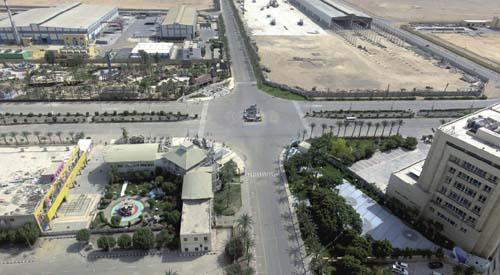FIVE YEARS ON
2018-10-21ByKerryBrown
By Kerry Brown

The Belt and Road Initiative has been with us for five years now. It first manifested itself as the new Silk Road in 2013 when Chinese President Xi Jinping was traveling fi rst in Central Asia and then in Indonesia. Since 2015, it has been known as the Belt and Road Initiative. Under that name it has been the focus of major conferences and summits in China, as well as across the rest of the world, including many countries and regions that were not originally associated with the idea. Everyone, it seems, wants to know about the Belt and Road Initiative and to work out what it means for them.
A fairer role
The practical impact of the Belt and Road Initiative has taken place in two primary domains. The first is that of actual realized projects, such as the construction of infrastructure and working in development schemes with various international partners. The rationale here is that after four decades of rapid industrialization and construction, China is in a position than before to show others how to undertake urbanization and build high speed railways and motorways, among other things. China, as a party to the exchange of knowledge, has usually been figured in ways which place it as a student, and the outside world—Europe, America and the developed world in particular—as its teachers. Now this situation has changed. No other country has lifted so many from poverty and built so much hard infrastructure in such a short period of time. It is now, therefore, the era of China the teacher, not China the student. The Belt and Road Initiative is one way that this is unfolding.
There is also the simple matter of mutual self-interest. China wishes to diversify and expand its overseas markets. It learned from the fi nancial crisis of 2008 that over-reliance on one area for exports is a vulnerability. Since then it has sought to expand the focus of its trading relations within its own region. Some of these have been stymied in the past by the lack of proper logistical and infrastructural support for supply chains. So China, through Belt and Road Initiative projects, is helping to put these in place, and to meet the vast unmet needs of the Asia region in terms of roads, railways, ports and other assets. In this way, the famous “win-win” of Chinese discourse becomes clear —China gets a better quality market to sell into and source goods from, and the partners in the region get physical infrastructure that helps them build their own economies. That, at least, is the most ideal outcome.
The second dimension of the Belt and Road Initiative is more abstract. This is the ways in which, not just for the region, but the wider world, it has served as the key idea for introducing ideas about why it is worth engaging with the Chinese economy, and how best to do so. A criticism made of China after its accession to the World Trade Organization in 2001 was that as its economy boomed and it grew in stature and importance, diplomatically the country seemed to lack a voice. In 2005, then U.S. trade representative Robert Zoellick complained that China was not a stakeholder in the global order, and that it needed to step forward and play a greater role. Frustratingly, there were times when China did precisely this and received complaints and criticisms. This catch-22 situation—a country which evidently needed a far higher profile and global role, and an outside world willing to see it take that role only if wholly on its own terms—has been partially resolved by the Belt and Road Initiative. The Belt and Road Initiative, in essence, has started a huge debate about what a larger, fairer role for China, with its unique economic and political model, actually means for everyone else.
That was never going to be an easy process to engage with. After all, the rise of other powers to greater prominence in the past has often caused turbulence. This is something that plenty inside and outside China have noted. But there is one thing worse than enduring the discomfort of sometimes talking about these diffi cult issues, and that is not engaging with them and pretending that, without uttering a word, they will automatically sort themselves out. The Belt and Road Initiative is part of a major international communication process, where everyone takes part in working out what a new order looks like when China has a position, status and role that is much more commensurate with the size of its economy and geopolitical infl uence. At least now more people are focusing on this than ever before, and trying to work through these issues collaboratively and creatively.
A new consensus
After five years of the Belt and Road Initiative concept, we can now draw some provisional conclusions. The fi rst, very obvious one, is that uptake for Belt and Road conferences in Europe, Latin America, and elsewhere shows that the wider world does want to think more about the role of China in their lives. The community of those that feel they have links with the country and need a conceptual framework to help them find the right ways to cooperate, work with, and think about China is increasing. Whatever people might believe, whether it is negative, positive or neutral, at least they feel that they now need to devote time to the issue. Complacent indifference toward what China is doing is no longer an option. That, broadly, is a good thing.
Secondly, the Belt and Road Initiative shows the complexity of Chinese influence and power, and the ways in which this has been interpreted by different audiences in vastly different ways. For some, the Belt and Road Initiative boils down to simply creating greater connectivity in terms of hard infrastructure, the Internet, people-topeople links and governance. For others, it is about introducing a Chinese philosophy, involving ideas like harmony, reciprocity and multi-polarity—a new set of geopolitical concepts harvested from the rich history of Chinese strategic thinking that reaches back millennia into the past. This could be an almost idealistic interpretation.
For a few, the Belt and Road Initiative is more about China finding its rightful global role in ways which play to its strengths—through economic prowess and performance—rather than in the areas where it might come into direct conflict with a United States increasingly wary and jealous of even the slightest perception that it is losing its global number one spot. This might be called the “grand strategy”approach.
All of these different aspects highlight one thing; that reaching consensus on what China and its new and increasingly global role mean for the lives of everyone else is perhaps the most urgent geopolitical discussion taking place at the moment, and one that cannot fail. A major misunderstanding between China and the United States, Europe, or anywhere else, would be in no ones interests. It would be the direct opposite of “win-win.” Everything has to be done, therefore, to forestall this eventuality.
Discussion about the Belt and Road Initiative has created multiple discourses and competing attitudes and convictions. Some of these conversations have proved difficult, such as arguments about imbalance and debt increasing for some of its partners. Expectations have sometimes gone too far ahead. It is, after all, early days. But the whole Belt and Road concept has at least begun to help China understand what it wants from the world around it, and what it thinks the optimal relationship with that world might be. It has also prompted an increasing number of people in the wider world to work out how and why they might want to work with China. A famous Chinese saying used in the early years of the Peoples Republic talks of a journey of a thousand miles starting with a single step. The Belt and Road Initiative is the single step in the great journey of China achieving a global role that needs to be balanced, sustainable and truly collaborative. That is not an easy goal, but it is one worth everyone striving for.
